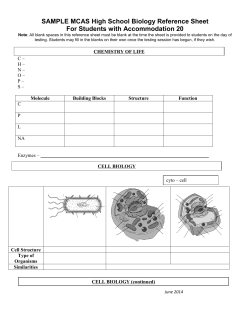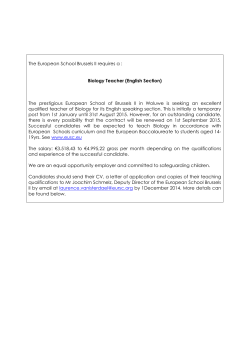
AP Biology
http://www.phschool.com/science/biology_
place/labbench/lab8/intro.html
AP Biology Lab
Population Genetics
{Hardy Weinberg}
AP Biology
A Large Breeding Population
Helps to ensure that chance alone
does not disrupt genetic equilibrium.
AP Biology
Random Mating
Population at equlibrium:
mating must be random.
Assortative mating: individuals
tend to choose mates similar to
themselves
AP Biology
does not alter allelic
frequencies, but results
in fewer heterozygous
individuals than you
would expect in a
population where mating
is random.
No Change in Allelic Frequency
Due to Mutation
Any mutation in a particular gene would
change the balance of alleles in the gene pool
Mutations may
remain hidden in
large populations
for a number of
generations, but
may show more
quickly in a small
population.
AP Biology
No Immigration or Emigration
Both immigration and emigration can
alter allelic frequency.
AP Biology
No Natural Selection
If selection occurs, those alleles that are
selected for will become more common.
AP Biology
Lab 8: Population Genetics
Description
simulations were used to study effects
of different parameters on frequency of
alleles in a population
selection
heterozygous advantage
genetic drift
AP Biology
Lab 8: Population Genetics
Concepts
Hardy-Weinberg equilibrium
p+q=1
p2 + 2pq + q2 = 1
required conditions
large population
random mating
no mutations
no natural selection
no migration
AP Biology
gene pool
heterozygous advantage
genetic drift
founder effect
bottleneck
Lab 8: Population Genetics
Conclusions
recessive alleles remain hidden
in the pool of heterozygotes
even lethal recessive alleles are not
completely removed from population
know how to solve H-W problems!
to calculate allele frequencies, use p + q = 1
to calculate genotype frequencies or how
many individuals, use p2 + 2pq + q2 = 1
AP Biology
Estimating Allelic Frequency
If a trait is controlled by two alternate
alleles, how can we calculate the
frequency of each allele?
For example, let us look at a sample
population of pigs.
The allele for black coat is
recessive to the allele for
white coat. Can you count the
number of recessive alleles in
this population?
Can you count the number of
dominant alleles?
AP Biology
The Hardy-Weinberg Equation
Used to estimate the frequency of alleles in a population,
According to this equation:
p = the frequency of the dominant allele (represented here by A)
q = the frequency of the recessive allele (represented here by a)
For a population in genetic equilibrium:
p + q = 1.0 (The sum of the frequencies of both alleles is 100%.)
(p + q)2 = 1
So
p2 + 2pq + q2 = 1
The 3 terms of this binomial expansion indicate the frequencies of
the 3 genotypes:
p2 = frequency of AA (homozygous dominant)
2pq = frequency of Aa (heterozygous)
q2 = frequency of aa (homozygous recessive)
This page contains all the information you need to calculate allelic
frequencies when there are two different alleles.
We start with some sample problems that will give you practice in
using the Hardy-Weinberg equation.
AP Biology
Sample Problem 1
The allele for black coat is recessive.
1.
2.
3.
4.
We can use the Hardy-Weinberg
equation to determine the percent of the
pig population that is heterozygous for
white coat.
Calculate q2
Find q.
Find p.
Find 2pq.
AP Biology
Sample Problem 1
The allele for black coat is recessive.
1.
2.
3.
4.
We can use the Hardy-Weinberg
equation to determine the percent of the
pig population that is heterozygous for
white coat.
Calculate q2
Find q.
Find p.
Find 2pq.
Answer:
Four of the sixteen individuals show the
recessive phenotype, so the correct
answer is 25% or 0.25.
AP Biology
What % of the pig population is
heterozygous for white/pink coat color?
1. Calculate q2
Count the homozygous recessive individuals in the illustration.
Calculate the percent of the total population they represent.
This is q2.
2. Find q. Take the square root of q2 to obtain q, the
frequency of the recessive allele.
3. Find p. The sum of the frequencies of both alleles = 100%,
p + q = l. You know q, so what is p, the frequency of the
dominant allele?
4. Find 2pq.
The frequency of the heterozygotes is
represented by 2pq. This gives you
the percent of the population that is
heterozygous for white coat:
AP Biology
What % of the pig population is
heterozygous for white/pink coat color?
1. Calculate q2
Count the homozygous recessive individuals in the illustration.
Calculate the percent of the total population they represent.
This is q2.
2. Find q. Take the square root of q2 to obtain q, the
frequency of the recessive allele.
3. Find p. The sum of the frequencies of both alleles = 100%,
p + q = l. You know q, so what is p, the frequency of the
Answers:
dominant allele?
Four of the 16 individuals show the
4. Find 2pq.
recessive phenotype,
The frequency of the heterozygotes is
so the correct answer is 25% or 0.25.
represented by 2pq. This gives you 2. q = 0.5
the percent of the population that is 3. p = 1 - q, so p = 0.5
4. 2pq = 2(0.5) (0.5) = 0.5 ,
heterozygous for white coat:
so 50% of the population is
AP Biology
heterozygous.
How many individuals would you
expect to be homozygous for red
eye color?
In a certain population of 1000 fruit
flies, 640 have red eyes while the
remainder have sepia eyes. The sepia
eye trait is recessive to red eyes.
Hint: The first step is always to calculate q2! Start by determining the
number of fruit flies that are homozygous recessive. If you need help
doing the calculation, look back at the Hardy-Weinberg equation.
AP Biology
How many individuals would you
expect to be homozygous for red
eye color?
In a certain population of 1000 fruit
flies, 640 have red eyes while the
remainder have sepia eyes. The sepia
eye trait is recessive to red eyes.
Answer:
You should expect 160 to be homozygous dominant.
Calculations:
q2 for this population is 360/1000 = 0.36
q = = 0.6
p = 1 - q = 1 - 0.6 = 0.4
The homozygous dominant frequency = p2 = (0.4)(0.4) = 0.16.
Therefore, you can expect 16% of 1000, or 160 individuals, to be homozygous dominant.
AP Biology
FRQ
Evolution is one of the unifying themes of biology. Evolution involves
change in the frequencies of alleles in a population. For a particular
genetic locus in a population, the frequency of the recessive allele (a) is
0.4 and the frequency of the dominant allele (A) is 0.6.
(a) What is the frequency of each genotype (AA, Aa, aa) in this
population? What is the frequency of the dominant phenotype?
(b) How can the Hardy-Weinberg principle of genetic equilibrium be
used to determine whether this population is evolving?
(c) Identify a particular environmental change and describe how it might
alter allelic frequencies in this population.
AP Biology
Lab 8: Population Genetics
FRQ
ESSAY 1989
Do the following with reference to the Hardy-Weinberg model.
a. Indicate the conditions under which allele frequencies (p and q)
remain constant from one generation to the next.
b. Calculate, showing all work, the frequencies of the alleles and
frequencies of the genotypes in a population of 100,000 rabbits of
which 25,000 are white and 75,000 are agouti.
(In rabbits the white color is due to a recessive allele, w, and agouti
is due to a dominant allele, W.)
c. If the homozygous dominant condition were to become lethal, what
would happen to the allelic and genotypic frequencies in the rabbit
population after two generations?
AP Biology
Application
The Hardy-Weinberg equation is useful for
predicting the percent of a human population that
may be heterozygous carriers of recessive alleles
for certain genetic diseases. Phenylketonuria
(PKU) is a human metabolic disorder that results
in mental retardation if it is untreated in infancy.
In the United States, one out of approximately
10,000 babies is born with the disorder.
Approximately what percent of the population are
heterozygous carriers of the recessive PKU
allele?
AP Biology
Design of the Experiment
The experiment in this laboratory is a test of
Hardy-Weinberg equilibrium in a "mating
population," represented by you and your
classmates. Your instructor will assign each
class member a genotype (AA, Aa, or aa). The
initial allelic frequency of the population will be
0.5 A and 0.5 a. Your population will simulate
several different conditions that might alter allelic
frequency, and you will determine the allelic
frequencies over several generations.
AP Biology
Analysis of Results
Your analyses should have included
Hardy Weinberg and Chi square.
http://www.phschool.com/science/biology_place/labbench/lab8/analysis.html
AP Biology
Any Questions??
AP Biology
© Copyright 2025










